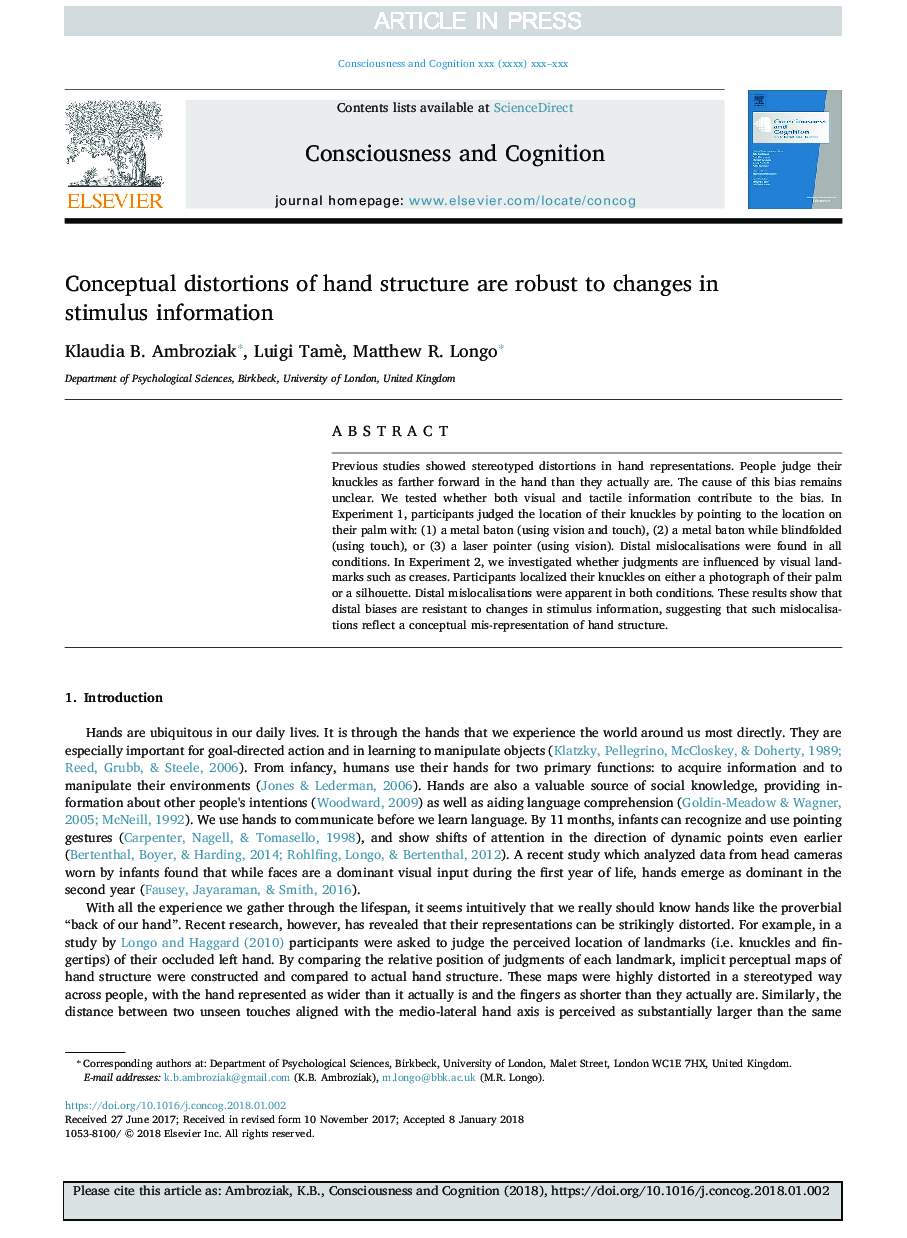| کد مقاله | کد نشریه | سال انتشار | مقاله انگلیسی | نسخه تمام متن |
|---|---|---|---|---|
| 7287972 | 1474150 | 2018 | 10 صفحه PDF | دانلود رایگان |
عنوان انگلیسی مقاله ISI
Conceptual distortions of hand structure are robust to changes in stimulus information
ترجمه فارسی عنوان
تحریفات مفهومی ساختار دست به تغییر در اطلاعات محرک قوی می انجامد
دانلود مقاله + سفارش ترجمه
دانلود مقاله ISI انگلیسی
رایگان برای ایرانیان
کلمات کلیدی
نمایندگی بدن، شرح ساختار بدن، دانش مفهومی، سوماتوزسنجی،
ترجمه چکیده
مطالعات قبلی نشان داد که اعوجاج کلیشه ای در نمایش های دست است. مردم قوچ خود را به صورت قهرمانانه در دست خودشان قضاوت می کنند تا اینکه در واقع هستند. علت این تعصب هنوز معلوم نیست. ما آزمایش کردیم که آیا اطلاعات بصری و لمسی به تعصب کمک می کند. در آزمایش 1، شرکت کنندگان موقعیت خود را با اشاره به محل در کف خود را با: (1) باتوم فلزی (با استفاده از بینایی و لمس)، (2) باتوم فلزی در حالی که چشم بسته (با استفاده از لمس)، و یا (3 ) اشاره گر لیزری (با استفاده از بینایی). در هر شرایطی، جایگزینهای دینامیکی یافت شد. در آزمایش 2، ما بررسی کردیم که آیا قضاوت ها تحت تأثیر نشانه های بصری مانند چروک قرار می گیرند یا خیر. شرکت کنندگان اسلحه خود را بر روی یک عکس از کف دست خود و یا یک شبح قرار دادند. اشتباهات دیستال در هر دو شرایط ظاهر شد. این نتایج نشان می دهد که تعصب های دفاعی نسبت به تغییرات اطلاعات محرک مقاوم هستند، و این نشان می دهد که چنین موقعیت هایی به صورت غیرمستقیم از ساختار دست نشان می دهد.
موضوعات مرتبط
علوم زیستی و بیوفناوری
علم عصب شناسی
علوم اعصاب شناختی
چکیده انگلیسی
Previous studies showed stereotyped distortions in hand representations. People judge their knuckles as farther forward in the hand than they actually are. The cause of this bias remains unclear. We tested whether both visual and tactile information contribute to the bias. In Experiment 1, participants judged the location of their knuckles by pointing to the location on their palm with: (1) a metal baton (using vision and touch), (2) a metal baton while blindfolded (using touch), or (3) a laser pointer (using vision). Distal mislocalisations were found in all conditions. In Experiment 2, we investigated whether judgments are influenced by visual landmarks such as creases. Participants localized their knuckles on either a photograph of their palm or a silhouette. Distal mislocalisations were apparent in both conditions. These results show that distal biases are resistant to changes in stimulus information, suggesting that such mislocalisations reflect a conceptual mis-representation of hand structure.
ناشر
Database: Elsevier - ScienceDirect (ساینس دایرکت)
Journal: Consciousness and Cognition - Volume 61, May 2018, Pages 107-116
Journal: Consciousness and Cognition - Volume 61, May 2018, Pages 107-116
نویسندگان
Klaudia B. Ambroziak, Luigi Tamè, Matthew R. Longo,
